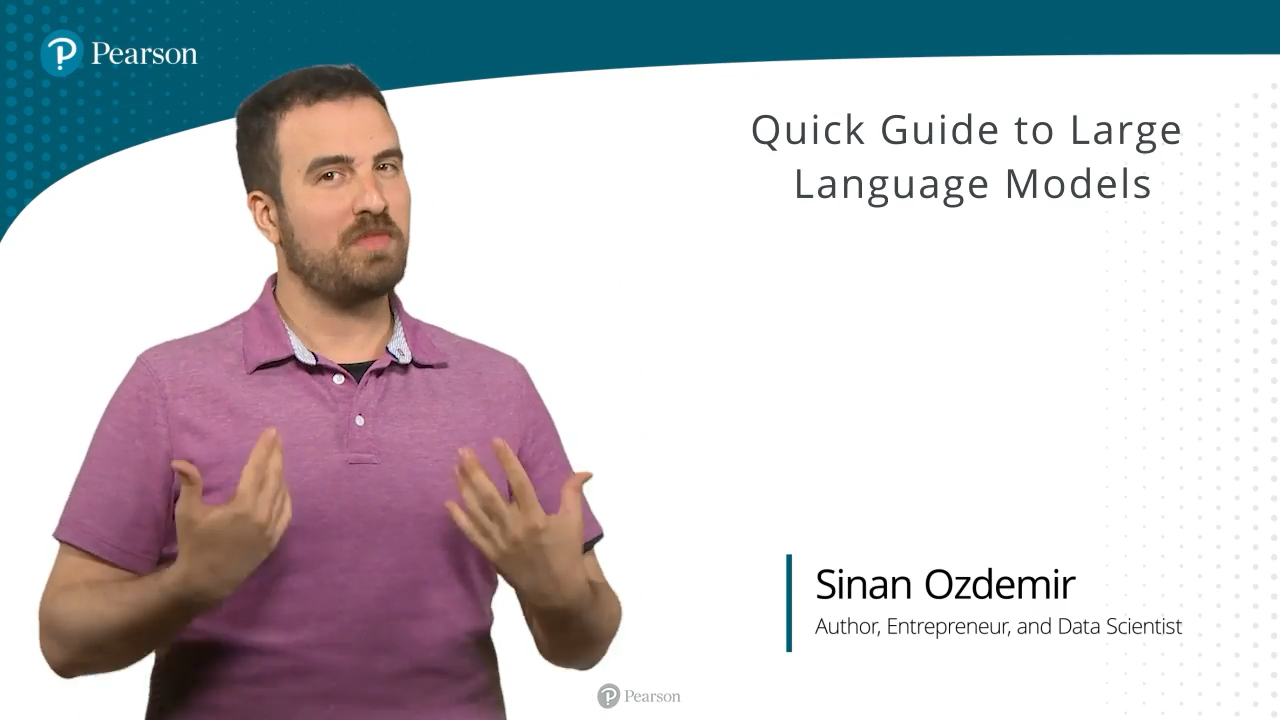Quick Guide to ChatGPT, Embeddings, and Other Large Language Models (LLMs): (Video Course)
- By Sinan Ozdemir
- Published Nov 17, 2023 by Addison-Wesley Professional.
Online Video
- Your Price: $279.99
- List Price: $349.99
- About this video
Video accessible from your Account page after purchase.
Register your product to gain access to bonus material or receive a coupon.
Description
- Copyright 2024
- Edition: 1st
- Online Video
- ISBN-10: 0-13-823699-2
- ISBN-13: 978-0-13-823699-1
9+ Hours of Video Instruction
Learn how to use and launch large language models (LLMs) like GPT, T5, and BERT at scale with real-world case studies.
Overview:
Quick Guide to ChatGPT, Embeddings, and Other Large Language Models (LLMs) is a quick-start guide to help people use and launch LLMs like GPT, T5, and BERT at scale. It shows a step-by-step approach to building and deploying LLMs, with real-world case studies to illustrate the concepts. The video covers topics such as building recommendation engines with siamese BERT architectures, launching an information retrieval system with OpenAI embeddings and GPT3, and building an image captioning system with the vision transformer and GPT-J. This guide provides clear instructions and best practices for using LLMs. It fills a gap in the market by providing a guide to using LLMs and will be a valuable resource for anyone looking to use LLMs in their projects.
Large language models (LLMs) are a type of artificial intelligence (AI) that use deep learning to process natural language. LLMs are trained on large datasets of text and can be used to generate text, answer questions, and perform other tasks related to natural language processing. LLMs are becoming increasingly popular for a variety of applications, such as recommendation engines, information retrieval systems, image captioning, and translation/summarization pipelines. LLMs are also being used to build chatbots to have conversations that change their style of speaking depending on who they are talking to. LLMs are powerful tools that can help organizations and individuals make sense of large amounts of data and generate insights that would otherwise be difficult to obtain.
Related Learning:
- Book: Quick Start Guide to Large Language Models, https://learning.oreilly.com/library/view/quick-start-guide/9780138199425/
- Video: Introduction to Transformer Models for NLP, https://learning.oreilly.com/videos/introduction-to-transformer/9780137923717/
- Live Training: https://learning.oreilly.com/search/?q=sinan%20ozdemir&type=live-event-series
- Audio: AI Unveiled, https://learning.oreilly.com/videos/ai-unveiled-audio/9780138364885/
Skill Level:
- Intermediate
- Advanced
Learn How To:
- Launch an application using proprietary models with an example of an information retrieval system with OpenAI embeddings and GPT3 for Question/Answering.
- Fine-tune GPT3 with custom examples using their API to get better results.
- Learn the basics of prompt engineering with GPT3 to get more nuanced examples by building a chatbot with persona style depending on who they are talking to using the information retrieval system.
- Deploy custom LLMs to the cloud
Who Should Take This Course:
- Machine learning engineers with experience in ML, neural networks, and NLP
- Developers, data scientists, and engineers who are interested in using LLMs for their projects
- Those who want the best outputs from the GPT-3 or ChatGPT model
- Those interested in state-of-the-art NLP architecture
- Those interested in productionizing and fine-tuning LLMs
- Those comfortable using libraries like Tensorflow or PyTorch
- Those comfortable with linear algebra and vector/matrix operations
Course Requirements:
- Python 3 proficiency with some experience working in interactive Python environments including Notebooks (Jupyter/Google Colab/Kaggle Kernels)
- Comfortable using the Pandas library and either Tensorflow or PyTorch
- Understanding of ML/deep learning fundamentals including train/test splits, loss/cost functions, and gradient descent
About Pearson Video Training
Pearson publishes expert-led video tutorials covering a wide selection of technology topics designed to teach you the skills you need to succeed. These professional and personal technology videos feature world-leading author instructors published by your trusted technology brands: Addison-Wesley, Cisco Press, Pearson IT Certification, Sams, and Que Topics include: IT Certification, Network Security, Cisco Technology, Programming, Web Development, Mobile Development, and more. Learn more about Pearson Video training at http://www.informit.com/video.
Sample Content
Table of Contents
Introduction
Module 1: Introduction to Large Language Models
- Lesson 1: Overview of Large Language Models
- Lesson 2: Semantic Search with LLMs
- Lesson 3: First Steps with Prompt Engineering
Module 2: Getting the Most Out of LLMs
- Lesson 4: Optimizing LLMs with Fine-Tuning
- Lesson 5: Advanced Prompt Engineering
- Lesson 6: Customizing Embeddings + Model Architectures
Module 3: Advanced LLM Usage
- Lesson 7: Moving Beyond Foundation Models
- Lesson 8: Advanced Open-source LLM Fine-Tuning
- Lesson 9: Moving LLMs into Production
Summary
More Information

